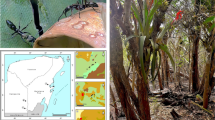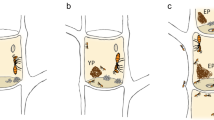An ant species uses herbicidal weaponry to secure its own niche in the Amazonian rainforest.
Abstract
‘Devil's gardens’ are large stands of trees in the Amazonian rainforest that consist almost entirely of a single species, Duroia hirsuta1,2,3,4,5, and, according to local legend, are cultivated by an evil forest spirit. Here we show that the ant Myrmelachista schumanni, which nests in D. hirsuta stems, creates devil's gardens by poisoning all plants except its host plants with formic acid. By killing these other plants, M. schumanni provides its colonies with abundant nest sites — a long-lasting benefit as colonies can live for 800 years.
This is a preview of subscription content, access via your institution
Access options
Subscribe to this journal
Receive 51 print issues and online access
$199.00 per year
only $3.90 per issue
Buy this article
- Purchase on Springer Link
- Instant access to full article PDF
Prices may be subject to local taxes which are calculated during checkout

M. DOHRN © BBC

Similar content being viewed by others
References
Davidson, D. W. & McKey, D. Trends Ecol. Evol. 8, 326–332 (1993).
Campbell, D. G, Richardson, P. M. & Rosas Jr, A. Biochem. Syst. Ecol. 17, 403–407 (1989).
Page, J. E., Madriñan, S. & Towers, G. H. N. Experientia 50, 840–842 (1994).
Aquino, R., De Tommasi, N., Tapia, M., Lauro, M. R. & Rastrelli, L. J. Nat. Prod. 62, 560–562 (1999).
Pfannes, K. R. & Baier, A. C. Rev. Biol. Trop. 50, 293–301 (2002).
Morawetz, W., Henzl, M. & Wallnöfer, B. Biodivers. Conserv. 1, 19–33 (1992).
Renner, S. S. & Ricklefs, R. E. Biotropica 30, 324–327 (1998).
Revis, H. C. & Waller, D. A. Auk 121, 1262–1268 (2004).
Odling-Smee, F. J., Laland, K. N. & Feldman, M. W. Niche Construction: The Neglected Process in Evolution (Princeton Univ. Press, Princeton, 2003).
Author information
Authors and Affiliations
Corresponding author
Ethics declarations
Competing interests
The authors declare no competing financial interests.
Supplementary information
Supplementary Methods
This file contains detailed methods for the experiments and analyses described in the article. (DOC 28 kb)
Rights and permissions
About this article
Cite this article
Frederickson, M., Greene, M. & Gordon, D. ‘Devil's gardens’ bedevilled by ants. Nature 437, 495–496 (2005). https://doi.org/10.1038/437495a
Published:
Issue Date:
DOI: https://doi.org/10.1038/437495a
This article is cited by
-
Ant pollination, phenology, and breeding system of Microstachys serrulata (Mart. & Zucc.) Müll. Arg. (Euphorbiaceae) in the Brazilian savanna
Plant Ecology (2022)
-
Uncovering how behavioral variation underlying mutualist partner quality is partitioned within a species complex of keystone seed-dispersing ants
Insectes Sociaux (2022)
-
An experimental test of ant effects on herbivory and pathogen infection on wild cotton (Gossypium hirsutum L.)
Arthropod-Plant Interactions (2022)
-
How to prioritize areas for new ant surveys? Integrating historical data on species occurrence records and habitat loss
Journal of Insect Conservation (2020)
-
Mating system, population genetics, and phylogeography of the devil’s garden ant, Myrmelachista schumanni, in the Peruvian Amazon
Insectes Sociaux (2020)
Comments
By submitting a comment you agree to abide by our Terms and Community Guidelines. If you find something abusive or that does not comply with our terms or guidelines please flag it as inappropriate.



